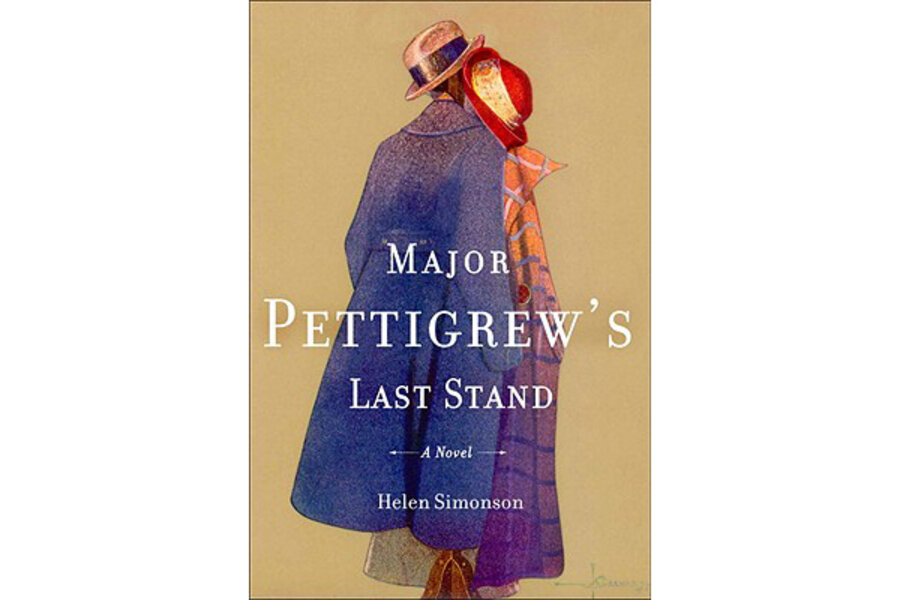Major Pettigrew's Last Stand
Loading...
The most romantic hero of 2010 couldn’t be played by Robert Pattinson – with or without a tan. In fact, Hollywood wouldn’t have a clue what to do with Major Ernest Pettigrew. For one thing, he’s a stuffy sexagenarian who first appears wearing a bright-pink floral robe. (It belonged to his late wife.) And for another, he’d find the whole business of appearing on screen to be in appallingly bad taste.
But Helen Simonson’s dryly delightful debut novel, Major Pettigrew’s Last Stand is, nonetheless, one of the most endearing love stories I’ve read in a long time. (My copy is already on its way to my mom, and I have a growing list of people who are getting the book as a present.)
After the death of his brother, Bertie, the major finds himself unexpectedly unmoored. He strikes up a friendship with Mrs. Ali, the widowed local shopkeeper, and they bond over Kipling and the loss of their spouses. It doesn’t hurt that Mrs. Ali is a lady of quiet thoughtfulness and innate dignity – whose tweedy neighbors don’t even see her because she is Pakistani and runs a shop. Mrs. Ali might not be running the shop for much longer: Her relatives are pressuring her to give it to a nephew, who will, in return for her generosity, let her continue to live in what used to be her home.
Neither the major nor Mrs. Ali were expecting much more from life, and both are startled at the potential widening of their future. (But both are careful to call it just a friendship.) “It’s funny,” Mrs. Ali tells him, “to be suddenly presented with the possibility of making new friends. One begins to accept, at a certain age, that one has already made all the friends to which one is entitled. One becomes used to them as a static set – with some attrition, of course.”
As their friendship grows, Major Pettigrew finds himself thrust from his comfortable routine and having to face the fact that Edgecombe St. Mary might not be the staunch remnant of right thinking that he’s loved all these years.
In the much-scrutinized world of the village, your neighbors judge you even by the cookies you eat. Shortbread is decorous; iced varieties are apparently embarrassing. (What they would make of an Oreo, I shudder to think.) When the village ladies (led by Daisy, the vicar’s wife) pay a condolence call on the major, they bring tea (dusty stuff in tea bags) and biscuits. “The tin was printed with views of thatched cottages of England and the biscuits were appropriately tumescent; stuffed with fudge, dribbled with pastel icing, or wrapped in assorted foils. He suspected that Alma had picked it out.
“Unlike her husband, Alec, who was proud of his history as an East End boy, Alma tried hard to forget her origins in London; but she sometimes betrayed herself with a taste for showy luxuries and the sweet tooth of someone who grew up without quite enough to eat. The other ladies, he suspected, were hiding their mortification.”
When all this gentility and good breeding turns its attention to race relations, the result is ripe for satire.
Complicating matters further are Bertie’s widow, currently in possession of a Churchill rifle (one of a matched pair) that was always supposed to come to the major; Pettigrew’s grasping son, Roger; and an angry single mother named Amina and her son, George. Simonson is as sure-handed at social satire as she is at romance, and the combination makes for an entirely satisfying read.
Lots of books try to evoke Jane Austen, as if naming a character Darcy were all it took. But Simonson nails the genteel British comedy of manners with elegant aplomb. There are occasional touches that recall Austen. For example, Simonson conjures up Capt. Frederick Wentworth with one sentence: “If there was one trait the Major despised in men, it was inconstancy.” And the annual golf club dance devolves into a debacle that simultaneously calls to mind the Netherfield Ball and makes Lydia Bennet look like a pattern-card of model behavior.
With her dry wit and incisive detailing, Simonson skewers village life as surely as Austen satirized the 19th century. (However, the impoverished Lord Dagenham, who rents out most of his home to a boys’ school, and the terrifying vicar’s wife could have come straight from central casting.) Then there is Roger’s American fiancée, Sandy, who arrives “perfectly dressed for a literary version of the countryside or perhaps an afternoon in Tunbridge Wells,” but is perhaps less of a total loss than Roger, who finds his dad an outdated old fuddy-duddy. When Roger and Sandy buy a cottage from a racist old lady, Roger pooh-poohs his father’s objections. “It’s called the real world. If we refused to do business with the morally questionable, the deal volume would drop in half and the good guys like us would end up poor. Then where would we all be?”
“ ‘On a nice dry spit of land known as the moral high ground?’ suggested the Major.”
Fans of Austen and Alexander McCall Smith should adore “Major Pettigrew’s Last Stand.” My only real concern now is: How long will it take Simonson to write her next novel?
Yvonne Zipp regularly reviews fiction for the Monitor.






